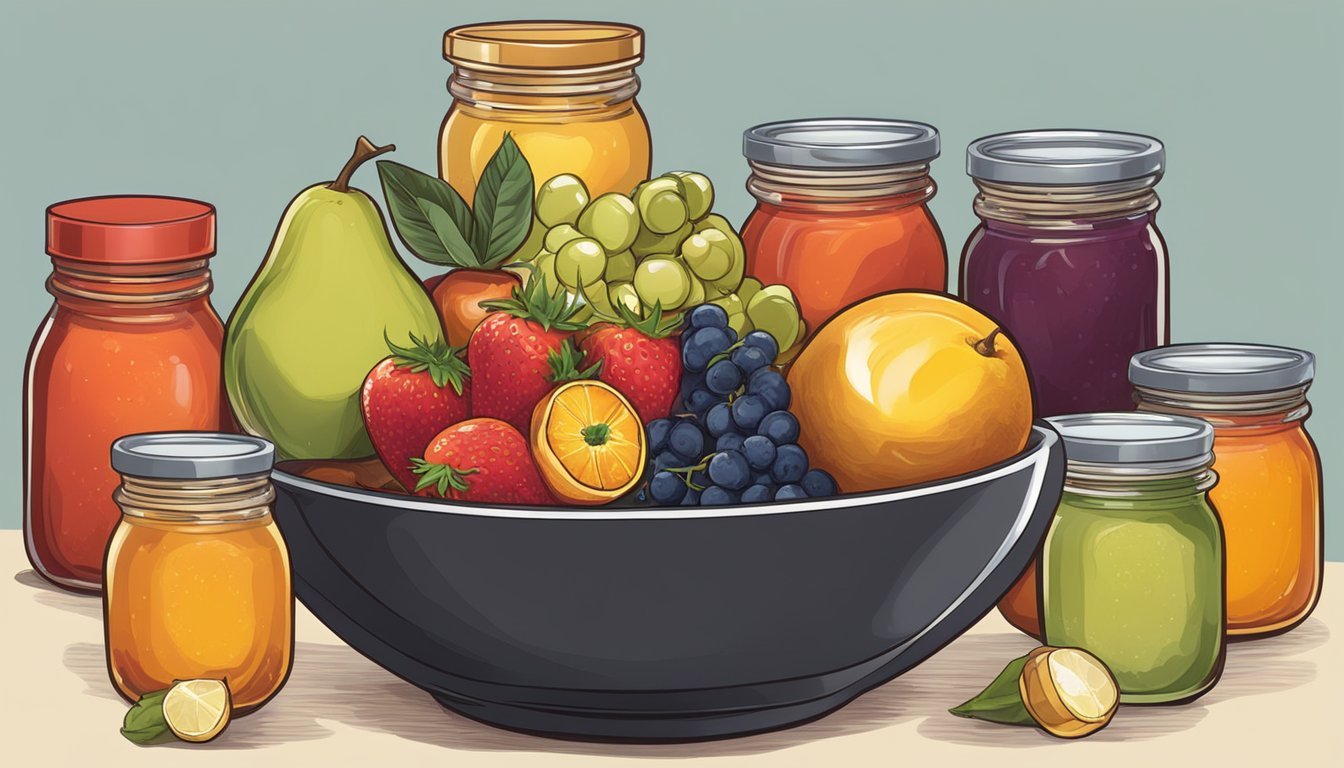Sweet Meets Heat
Expert Tips for Pairing Fruits with Spicy Condiments
The culinary trend of blending sweet and spicy flavors is not only intriguing but also an art form that tantalizes taste buds in unexpected ways. This fusion creates a multi-layered taste experience that can elevate the most basic dish to new heights. It has gained traction in everything from fast food to fine dining, as chefs experiment with various fruits and spicy condiments to find the perfect balance that delivers a harmony of flavors. Fruits (What wine goes well with fruits?), with their natural sweetness, are an excellent canvas for the fiery kick of spices, providing a refreshing contrast that can enhance the overall flavor profile of a meal.
When pairing fruits with spicy condiments, the inherent sweet flavors of fruits such as mango, pineapple, and berries can expertly counterbalance the heat from condiments like sriracha, hot honey, or spicy jams. The result is a flavor pairing that can both soothe and excite the palate simultaneously. This approach to pairing is sensitive to the nuances that each fruit and condiment bring to the table, allowing for a rich diversity of combinations that can suit different preferences and culinary applications.
Understanding the underlying profiles of both sweet and spicy elements is crucial in creating pairings that are not only delicious but also intriguing. The right match can make the heat from spices more palatable by allowing the subtleties of the spice to shine without overwhelming the senses. The appeal of these combinations lies in their ability to deliver a complex depth of flavor that can make a dish memorable while highlighting the individual characteristics of the paired elements.
The Foundations of Flavor Pairing
When it comes to combining sweet fruits with spicy condiments, understanding the foundations of flavor pairing is essential. Harmonious pairings can enhance the dining experience by creating new taste profiles that delight the palate.
Understanding Sweetness
Sweetness in fruits, such as the natural sugars in honey or maple syrup, is detected by taste buds as a pleasurable sensation. This is because sweet flavors can offset the harshness of spiciness and provide a soothing counterpoint. Common sweet fruits that are used in pairing include mangos, peaches, and berries. They work well with spices by offering a refreshing contrast to the heat.
Exploring Spiciness
Spiciness, often found in chili, cayenne, and other peppers, triggers taste buds with a sensation of heat. Spicy flavors are not just about the intensity but also about the depth they bring to dishes. When paired correctly, spicy condiments can highlight sweet notes in fruits, leading to layers of flavors that intrigue the senses.
Balancing Flavors
Flavor pairing is about achieving balance between the five main taste profiles: sweet, salty, sour, bitter, and savory. In the context of fruit and spicy condiments:
Sweet: Natural fruit sugars make heat more palatable, easing the spicy sensation.
Spicy/Hot: Compounds like capsaicin in peppers provide a kick that can enhance fruit's sweetness.
Balance: Pairings should aim for a balance that neither overwhelms the sweetness of the fruit nor the spice of the condiment. They should complement each other without one overpowering the other.
Using these principles, one can confidently create a variety of captivating dishes that combine the refreshing sweetness of fruits with the bold complexities of spicy condiments.
Pairing Fruits and Spices
Pairing fruits with spices can elevate the taste experience by balancing sweet flavors with a heat that accentuates the fruit's freshness and zest. Here are some specific combinations to explore.
Citrus and Heat Combinations
Citrus fruits like lemon, lime, orange, and grapefruit are vibrant and tangy, offering a sharp contrast to the warmth of spices. A classic pairing involves a dash of cayenne pepper with lime to enhance Mexican dishes or to rim a glass for a cocktail. Lemon juice with a hint of ginger can create a refreshing yet warm beverage or glaze.
Orange and cardamom make for an aromatic duo, especially in baked goods.
Grapefruit with a sprinkle of chili powder can add an unexpected twist to a fruit salad.
Tropical Touches
Tropical fruits such as mango, pineapple, and coconut naturally complement spicy condiments due to their bold, sweet flavors. The fruit's sweetness acts as a counterbalance to the spice's intensity.
Mango pairs beautifully with cayenne pepper or hot chili sauces in salsas and chutneys.
Pineapple and chili create a dynamic taste profile, perfect for grilling or in jams.
Coconut, with its creamy texture, often harmonizes with ginger or cayenne in savory curry dishes.
Stone Fruit and Spice Matches
Stone fruits such as peach, nectarine, apricot, plum, and cherry can match well with warm spices, creating depth in both sweet and savory presentations.
Peach or nectarine with a pinch of cayenne pepper can bring a kick to jams or marinades.
Apricot and vanilla with a whisper of heat from cardamom can be delightful in desserts or sauces.
Plum and cherry benefit from the addition of ginger or vanilla in pies or compotes, adding complexity to their rich taste profile.
Condiments and Fruit Pairings
Exploring the dynamic world where the sweetness of fruits meets the zesty kick of spicy condiments, this section delves into three innovative ways to pair flavors that tantalize the palate.
Sweet and Spicy Sauces
Sweet and spicy sauces bring a harmonious balance to fruit pairings. For example, a pineapple and chili jam can elevate a cheese plate or transform grilled chicken into an exotic dish. The gentle sweetness of the pineapple pairs seamlessly with the heat of chili peppers, offering a versatile sauce that complements both savory and sweet dishes.
Chutneys: Mango chutney laced with cayenne pepper creates a tropical twist perfect for summer barbecues.
Sauce Pairings:
Peaches & Habanero: A syrupy glaze that's ideal for pork or shrimp.
Berries & Jalapeño: A daring topping for ice cream or cheesecakes.
Infusing Syrups with Heat
Infused syrups are a subtle means to introduce spicy notes to mild fruits, ushering in complexity. A simple syrup infused with cayenne and cinnamon serves as a delightful drizzle over cantaloupe or watermelon, enhancing the fruit's natural flavors.
Maple Syrup Infusions: Maple syrup and a pinch of chili powder can be drizzled over roasted root vegetables or added to cocktail mixes for a smoky sweetness.
Honey mix-ins:
Honey & Ancho Chili: Gives a smoky touch to salad dressings.
Honey & Black Pepper: Offers a surprising spike to drizzle over roasted figs.
Herb and Spice Blends for Melons
Melons, with their lush texture and refreshing taste, serve as an ideal canvas for herb and spice blends. Mint finely chopped and sprinkled with chili pepper flakes on watermelon chunks introduces a refreshing but fiery experience.
Cantaloupe Pairings:
Cantaloupe & Paprika: A dusting of paprika on cantaloupe can accentuate the melon's sweetness.
Cantaloupe & Black Pepper: Ground black pepper offers an earthy heat to the fruit.
By integrating these condiments and spices with fruits, food enthusiasts can craft palatable adventures that balance sweetness and heat in every bite.
Recipes and Applications
Exploring the dynamic between fiery spices and fresh fruit adds a sophisticated edge to a variety of dishes and drinks. Well-chosen pairings can transform the mundane into the extraordinary with just a hint of heat or a burst of fruity sweetness.
Spicy Fruit Cocktails
Cocktails offer a vibrant playground for the sweet and spicy combination. A particularly popular concoction is a Spicy Fruit Mojito, where the traditional mint and lime are augmented with muddled fruit like pineapple or mango and a kick of jalapeño. A Peachy Sriracha Margarita gives a sweet-smooth contrast with peach puree and a sriracha salt rim. In these drinks, white spirits such as rum or gin are commonly used for their subtle flavors that don’t overpower the fruit and spice nuances.
Spicy Fruit Mojito
Muddled Pineapple
Fresh Jalapeño
White Rum
Mint Leaves
Lime Juice
Simple Syrup
Peachy Sriracha Margarita
Peach Puree
Sriracha Salt Rim
Silver Tequila
Lime Juice
Agave Nectar
Desserts with a Kick
Desserts are an unexpected platform for spicy accents. Chocolate, a natural for sweet-meets-spicy, gets an upgrade with cayenne or cinnamon for an inviting warmth. Vanilla ice cream isn't just a cool treat when paired with a spicy fruit compote or a sprinkle of toasted, crushed coriander seeds. Fruit-based desserts, (What wine goes well with fruit-based desserts?) such as a Strawberry-Cayenne Sorbet, balance the line between refreshing and bold, surprising the palate.
Chocolate with Cayenne
Incorporates a subtle amount of ground cayenne
Perfect for truffles or molten lava cakes
Vanilla Ice Cream with Spicy Fruit Compote
Stone fruit compote with a touch of cumin or coriander
Served over creamy vanilla ice cream
Savory Dishes with Fruit Accents
Savory applications sparkle when fruit and spice are combined. Consider a Mango-Cumin Glazed Chicken, where the tropical sweetness of mangoes and the earthy notes of cumin create a distinguished flavor profile. Salads gain complexity from a Spicy Citrus Vinaigrette made with blood oranges injected with a slight hint of cayenne. For a unique cheese pairing, a Jalapeño-Apple Chutney can accompany bold cheeses, adding layers of heat and sweetness.
Mango-Cumin Glazed Chicken
Ripe Mango Puree
Toasted Ground Cumin
For brushing on grilled or baked chicken
Spicy Citrus Vinaigrette
Blood Orange Juice
Olive Oil
Cayenne Pepper
Jalapeño-Apple Chutney
Diced Green Apples
Minced Jalapeños
Great with cheddar or gouda cheese
Seasonal and Cultural Inspirations
As the seasons change, they bring distinctive fruits and heat pairings that enliven taste buds across various cultures. These pairings are celebrated for their alignment with the seasonal produce and cultural cooking traditions.
Summer Pairings
During the summer months, the warmth of the sun sweetens a variety of berries and fruits, which can be masterfully paired with spicy condiments. Jalapeño peppers, with their moderate heat, complement the sweetness of strawberries and can be used in jams or as a fresh salsa. Mangoes, when blended with a hint of chili powder and lime juice, create a refreshing balance for summer cocktails or as a topping for grilled fish. These combinations not only satisfy the quest for spicy-sweet flavors but also take advantage of the seasonal peak of these fruits.
Strawberries & Jalapeño: A vibrant salsa or spicy strawberry jam.
Mango & Chili Powder: A zestful cocktail mixer or a tangy fish topping.
Traditional Combinations
In many cultures, the fusion of fruit and spice is deeply rooted in traditional dishes. Mexican hot chocolate is an exquisite example that infuses the sweetness of chocolate with cayenne pepper and cinnamon, delivering a velvety drink with an invigorating kick. Additionally, horseradish, known for its potent heat, is often grated into sauces to accompany the sweetness of roasted beets or apples in Eastern European cuisines. These enduring combinations vividly depict how traditional recipes honor the rich dance between fruit sweetness and the pungency of spices.
Churros & Spicy Chocolate: A classic pairing where warm spices meet sugary dough.
Beets/Apples & Horseradish: A piquant touch to a sweet root vegetable or fruit.
Using these seasonal and cultural inspirations, one can explore the delightful interplay that exists between fruity sweetness and the exhilarating zeal of spicy flavors.
Practical Tips and Techniques
Crafting the perfect sweet and spicy pairing requires careful selection of high-quality ingredients with a balance of flavors, and an attention to how texture and aroma contribute to the overall experience.
Selecting Quality Ingredients
When choosing fruits for pairing with spicy condiments, one should prioritize freshness for the best flavor and texture. A ripe fruit not only provides optimal sweetness but also ensures a pleasant texture that complements the heat of spices. A vivid color, a firm yet slightly yielding touch, and a fresh, fragrant smell are good indicators of fruit quality.
For spices and spicy condiments, freshness is equally essential. They should possess a potent aroma and vibrant hue, indicating robust flavor and potency. The seeds of spices can imply freshness, with freshly ground seeds such as cumin or coriander offering a more intense heat and complexity than their pre-ground counterparts. Herbs like mint, rosemary, and lavender, when used fresh, provide a contrast that can enhance both the fruit's sweetness and the condiment's spiciness.
Pairing for Texture and Aroma
The textural contrast in a sweet and spicy pairing is crucial; it creates an enjoyable mouthfeel and can amplify the distinct flavors. A smooth, creamy fruit like banana or avocado can balance the coarser texture of a spicy salsa, while the crunch of an apple offers a counterpoint to smooth, spicy sauces.
Aroma plays a significant role in how individuals perceive taste. When pairing fruits and spicy condiments, consider complementary aromatic profiles. For instance, the floral notes of lavender pair well with berries, while the piney scent of rosemary complements the bright acidity of citrus fruits. Additionally, the addition of aromatic spices like cinnamon or nutmeg can bridge the gap between sweet fruits and hot spices, resulting in a deeply satisfying combination.
Health Benefits and Considerations
Pairing fruits with spicy condiments can offer various health benefits, such as increased antioxidant intake and improved digestion. It's important to balance these flavorful combinations within a diet that monitors sugar and salt content.
Antioxidant Properties of Fruits and Spices
Fruits, particularly berries, papaya, and pear, are rich in antioxidants, which protect the body against oxidative stress. Spices like cinnamon, cloves, and ginger are also high in antioxidants. Combining these fruits with spices can enhance the total antioxidant content of a meal.
Berries: High in Vitamin C and anthocyanins.
Cinnamon and Cloves: Contain compounds with anti-inflammatory properties.
Digestive and Metabolic Enhancements
Spicy condiments often contain ingredients like cumin and ginger, which may aid in digestion and boost metabolism. For example:
Ginger: Can help soothe the digestive system and reduce nausea.
Cumin: Is known to stimulate digestive enzymes and could potentially aid in weight loss efforts.
Dietary Balances
While fruits add natural sweetness and nutrients to a diet, adding spicy condiments should be done with consideration of their salt and sugar content. Achieving a dietary balance involves managing these added condiments to avoid excessive intake, which might lead to health issues like high blood pressure or imbalances in blood sugar levels.
Sugar: Opt for fruits and condiments with no added sugars to maintain a healthy glycemic load.
Salt: Choose low-sodium options or make homemade spicy condiments to control salt levels.
Conclusion
Pairing fruits with spicy condiments creates a balance of flavors that can both challenge and delight the taste buds. The fusion of sweet fruit with the heat of chili peppers produces a flavor profile that is dynamic and stimulating. Integrating this concept requires thoughtful consideration of the heat level to ensure it complements the natural sweetness of the fruit without overwhelming it.
The science behind why this combination works is rooted in how flavors interact on the palate. Sweetness can temper the sharpness of spices, allowing diners to appreciate the complexity of flavors without discomfort. Conversely, the introduction of spice to sweetness elevates the sensory experience, often bringing a surprising twist to familiar tastes.
When executed correctly, the pairing of sweet and heat introduces a novel taste experience that can be applied to numerous dishes, from appetizers to desserts. Chefs might employ this strategy to add vibrancy to their creations, achieving a harmonious balance that caters to adventurous and traditional palates alike.
Key Points to Remember:
Sweetness mitigates heat, enabling a richer appreciation of spices.
Spice adds a layer of complexity to sweet dishes.
Aim for balance to ensure flavors enhance rather than compete.
In executing these pairings, individuals should always consider their own and their guests' taste bud sensitivities and preferences. The wealth of available condiments, from pepper jellies to sriracha, means there are countless possibilities for creating a bouquet of flavors that sing in harmony, no matter the culinary canvas they adorn.
References
Source Key Points Today Identified the rise in sweet and spicy pairings, noting a significant menu presence increase. Mentioned the popularity of hot honey. Market Research Data Cited an increase in consumer preference for foods with some level of heat. Highlighted the introduction of the 'swicy' flavor trend in patisserie and chocolates. Culinary Guides Provided insights on condiment pairings, emphasizing the balance of taste, texture, and heat when matching with various dishes. Historical Context Discussed the origins and evolution of pepper jelly as a condiment that exemplifies the sweet-heat combination.
These sources offer a multi-faceted view on the emergence and application of fruit and spicy condiment pairings. Together, they examine the growing consumer interest, market trends, and innovative uses in both savory and sweet culinary contexts. Additionally, the historical background of staple condiments like pepper jelly lends insight into how traditional pairings continue to influence modern tastes.










